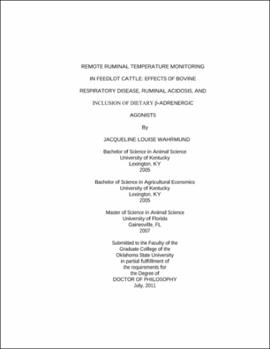| dc.contributor.advisor | Richards, Chris | |
| dc.contributor.author | Wahrmund, Jacqueline Louis | |
| dc.date.accessioned | 2013-11-26T08:22:40Z | |
| dc.date.available | 2013-11-26T08:22:40Z | |
| dc.date.issued | 2011-07 | |
| dc.identifier.uri | https://hdl.handle.net/11244/6628 | |
| dc.description.abstract | Ruminal temperature monitoring has potential as a useful tool to detect physiological changes in cattle resulting from illness and dietary changes. Heifer calves (n = 366, mean initial BW = 243 +/- 30 kg) were assigned to one of three experimental management methods: Pulled based on visual signs of bovine respiratory disease (BRD, CON), administered metaphylaxis on d 0 and subsequently pulled based on visual signs of BRD (MET), or pulled based on visual signs of BRD or elevated ruminal temperature (TEMP). Overall ADG generally decreased as number of times identified with BRD increased; however, overall ADG of TEMP heifers did not differ (P > 0.60) among those identified with BRD zero, one, or two times. Heifers identified with BRD twice began the finishing phase weighing 16.9 kg less (P < 0.01) than all others. Final BW of CON heifers identified with BRD twice was 37.5 kg less (P < 0.01) than CON heifers never identified, while number of times identified with BRD did not affect (P > 0.13) final BW of TEMP and MET heifers. Carcasses from CON heifers identified with BRD twice were valued at $92 less (P < 0.02) than those from other CON heifers, while carcass value of TEMP and MET heifers was not affected (P > 0.27) by number of times identified with BRD. To determine if temperature monitoring can detect ruminal acidosis, twelve ruminally cannulated steers (518 +/- 28 kg) were assigned to one of three acidosis challenge treatments: no dietary change (CON), half of daily DMI replaced with cracked corn (HALF), or all of daily DMI replaced with cracked corn (CORN). Ruminal pH was negatively correlated (P < 0.02) with ruminal pH in HALF and CON steers on d 1 and 3, respectively. The amount of time above ruminal temperature of 39.0 or 39.45 degree C was correlated (P < 0.05) with time spent below a ruminal pH of 5.5 in CORN steers. To determine if body temperature is affected by dietary inclusion of ZH, 67 steers, 73 fall-finished heifers, and 163 spring-finished heifers were assigned to control or ZH (7.3 mg/kg ZH) diets. Experimental periods included prior to (1) and during (2) ZH inclusion, and the withdrawal period (3). Temperatures of control steers increased by 0.10 degrees C from period 1 to period 3, while temperatures of ZH steers remained steady between periods 1 and 2, and increased by 0.15 degrees C during period 3. In fall-finished heifers, temperatures of control calves decreased by 0.17 degrees C from period 1 to period 2, and tended (P = 0.07) to decrease by 0.05 degrees C from period 2 to period 3. Temperatures of fall-finished heifers offered ZH decreased by 0.18 degrees C from period 1 to period 2, but increased by 0.06 degrees C from period 2 to period 3. Temperatures of spring-finished heifers were not affected (P > 0.15) by treatment. Results indicate that metaphylaxis and ruminal temperature monitoring may assist in identification of subclinical BRD, that temperature monitoring may have the ability to detect ruminal temperature changes that correspond with declining ruminal pH, and that ZH does not increase ruminal temperature. | |
| dc.format | application/pdf | |
| dc.language | en_US | |
| dc.rights | Copyright is held by the author who has granted the Oklahoma State University Library the non-exclusive right to share this material in its institutional repository. Contact Digital Library Services at lib-dls@okstate.edu or 405-744-9161 for the permission policy on the use, reproduction or distribution of this material. | |
| dc.title | Remote ruminal temperature monitoring in feedlot cattle: Effects of bovine respiratory disease, ruminal acidosis, and inclusion of dietary B-adrenergic agonists | |
| dc.contributor.committeeMember | Krehbiel, Clint | |
| dc.contributor.committeeMember | Step, Douglas L. | |
| dc.contributor.committeeMember | Goad, Carla | |
| osu.filename | Wahrmund_okstate_0664D_11582.pdf | |
| osu.accesstype | Open Access | |
| dc.type.genre | Dissertation | |
| dc.type.material | Text | |
| dc.subject.keywords | acidosis | |
| dc.subject.keywords | beef cattle | |
| dc.subject.keywords | beta-agonists | |
| dc.subject.keywords | body temperature | |
| dc.subject.keywords | bovine respiratory disease | |
| dc.subject.keywords | management | |
| thesis.degree.discipline | Animal Nutrition | |
| thesis.degree.grantor | Oklahoma State University | |
